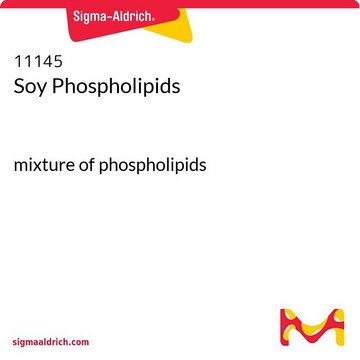840052C
Avanti
Heart PC
Avanti Research™ - A Croda Brand 840052C
Sinónimos:
L-α-phosphatidylcholine (Heart, Bovine)
About This Item
Productos recomendados
Análisis
>99% (TLC)
formulario
liquid
envase
pkg of 1 × 2.5 mL (840052C-25mg)
pkg of 2 × 4 mL (840052C-200mg)
pkg of 5 × 4 mL (840052C-500mg)
fabricante / nombre comercial
Avanti Research™ - A Croda Brand 840052C
concentración
10 mg/mL (840052C-25mg)
25 mg/mL (840052C-200mg)
25 mg/mL (840052C-500mg)
tipo de lípido
phosphoglycerides
phospholipids
Condiciones de envío
dry ice
temp. de almacenamiento
−20°C
InChI
1S/C42H80NO8P/c1-6-8-10-12-14-16-18-20-21-23-25-27-29-31-33-35-42(45)51-40(39-50-52(46,47)49-37-36-43(3,4)5)38-48-41(44)34-32-30-28-26-24-22-19-17-15-13-11-9-7-2/h14,16,20-21,40H,6-13,15,17-19,22-39H2,1-5H3/b16-14-,21-20-/t40-/m1/s1
Clave InChI
JLPULHDHAOZNQI-ZTIMHPMXSA-N
Descripción general
Aplicación
Acciones bioquímicas o fisiológicas
Envase
Información legal
Palabra de señalización
Danger
Frases de peligro
Clasificaciones de peligro
Acute Tox. 3 Inhalation - Acute Tox. 4 Oral - Carc. 2 - Eye Irrit. 2 - Repr. 2 - Skin Irrit. 2 - STOT RE 1 Oral - STOT SE 3
Órganos de actuación
Liver,Kidney, Respiratory system
Código de clase de almacenamiento
6.1D - Non-combustible acute toxic Cat.3 / toxic hazardous materials or hazardous materials causing chronic effects
Clase de riesgo para el agua (WGK)
WGK 3
Punto de inflamabilidad (°F)
does not flash
Punto de inflamabilidad (°C)
does not flash
Certificados de análisis (COA)
Busque Certificados de análisis (COA) introduciendo el número de lote del producto. Los números de lote se encuentran en la etiqueta del producto después de las palabras «Lot» o «Batch»
¿Ya tiene este producto?
Encuentre la documentación para los productos que ha comprado recientemente en la Biblioteca de documentos.
Nuestro equipo de científicos tiene experiencia en todas las áreas de investigación: Ciencias de la vida, Ciencia de los materiales, Síntesis química, Cromatografía, Analítica y muchas otras.
Póngase en contacto con el Servicio técnico![C11 TopFluor™ Galactosyl Ceramide N-[11-(dipyrrometheneboron difluoride)undecanoyl]-D-galactosyl-β1-1′-D-erythro-sphingosine, powder](/deepweb/assets/sigmaaldrich/product/images/246/046/3bdfc7ea-d7b5-45cf-b4d0-b7f21ea91875/640/3bdfc7ea-d7b5-45cf-b4d0-b7f21ea91875.jpg)










